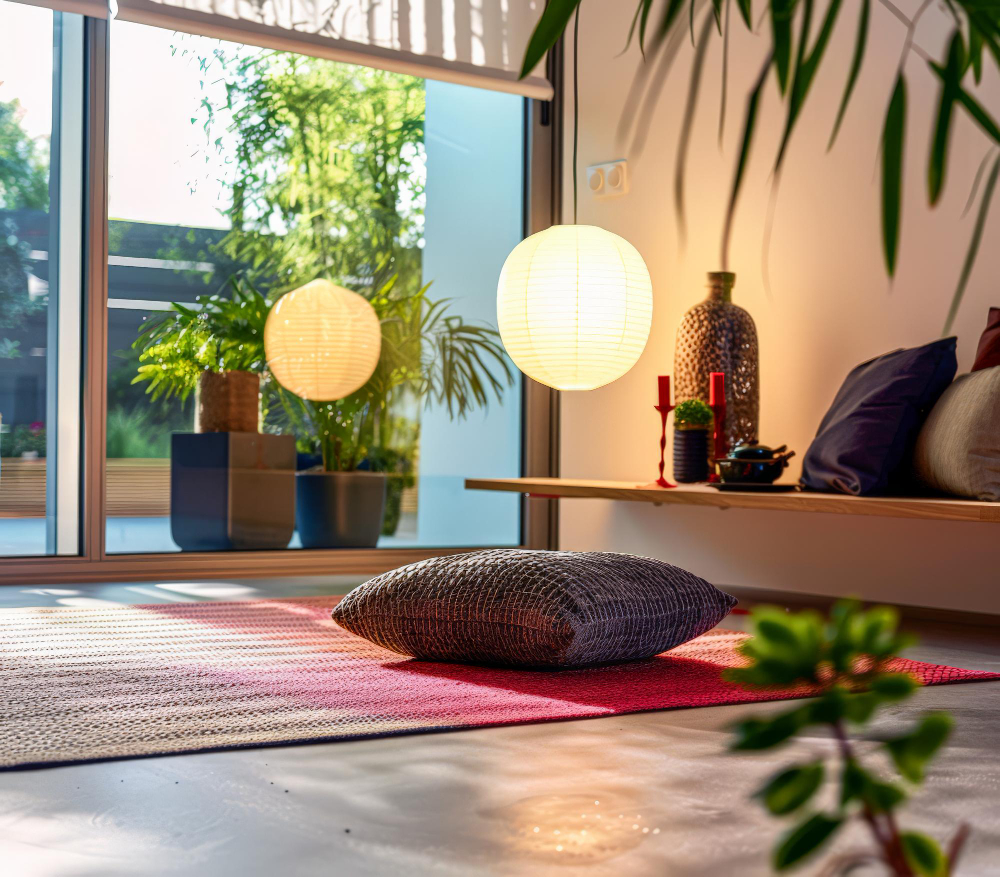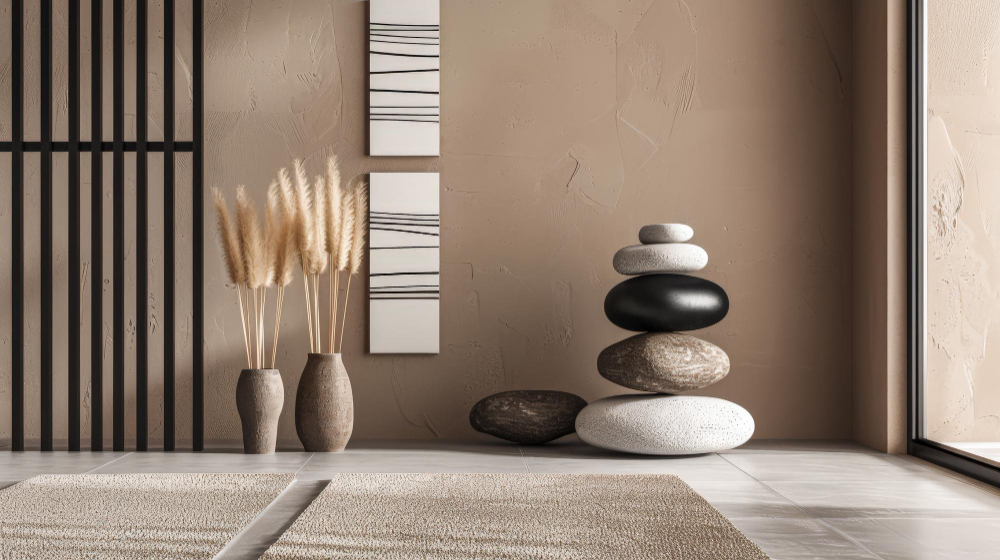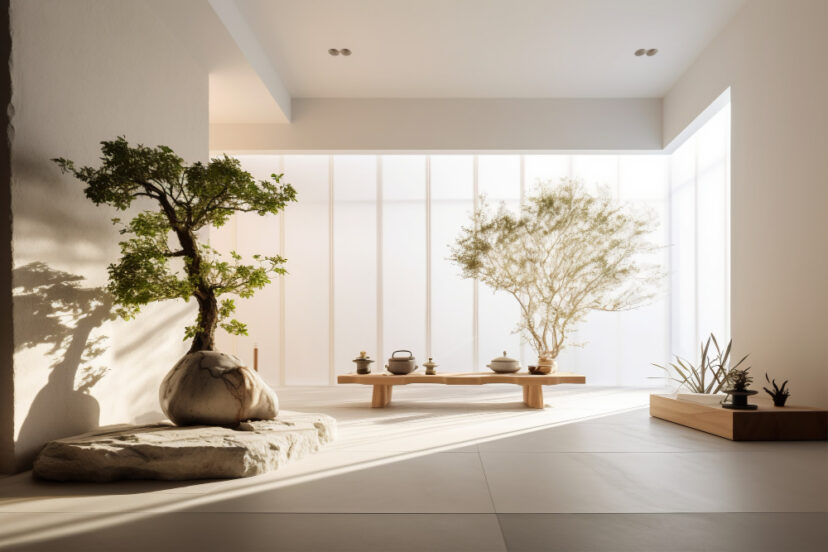Your Zen Space
Creating a Zen Space: Your Guide to Inner Peace
In our fast-paced, always-connected world, finding a moment of peace can feel like searching for a needle in a haystack. Our world, as it stands, is not created for calm. But what if I told you that you could create your own oasis of calm right in your home? Perhaps it’s time to create your own zen space – your personal sanctuary for meditation and mindfulness.
The Magic of a Zen Space: More Than Just a Pretty Corner
Picture this: You’ve had a day that feels like it’s been pulled straight from a sitcom – the kind where everything that could go wrong, did. Your boss was on a rampage, your coffee maker decided to take the day off, and don’t even get me started on that traffic jam. But then, you step into your zen space. Suddenly, the world outside fades away. The soft glow of candles, the gentle trickle of a small fountain, and the comforting aroma of lavender envelop you. You take a deep breath, and for the first time all day, you feel your shoulders relax. This, my friend, is the magic of a zen space.
Why Your Soul Craves a Zen Space
A zen space isn’t just a trendy home decor concept – it’s a lifeline in our chaotic world. Here’s why your soul is probably doing cartwheels at the mere thought of having one:
- It’s Your Personal ‘Time-Out’ Corner: Remember when you were a kid, and ‘time-out’ was a punishment? Well, adulting has turned that concept on its head. Now, we’d give our right arm for a mandated break from the world. A zen space gives you permission to take that break, guilt-free.
- It’s a Habit-Forming Superpower: Let’s face it, forming new habits is about as easy as teaching a cat to fetch. But having a dedicated zen space makes it infinitely easier to stick to your meditation practice. It’s like your brain goes, “Oh, we’re in the zen space now? Time to zen out!”
- It’s Your Focus-Boosting Secret Weapon: In a world where our attention spans are shorter than a goldfish’s (no, really, look it up!), a zen space helps you train your brain to focus. It’s like a gym for your concentration muscles.
- It’s Your Emotional Support… Space: Bad day? Relationship troubles? Burnt your toast? Your zen space is always there, ready to give you a metaphorical hug and help you sort through your feelings.

Designing Your Zen Space: Where Form Meets Function (and Serenity)
Now that you’re convinced you need a zen space (and let’s be honest, who isn’t?), let’s talk about how to create one that would make even the Dalai Lama a bit envious.
Location, Location, Location: Finding the Perfect Spot for Your Zen Space
First things first – you need to find the right spot for your zen space. This isn’t about feng shui (although that’s cool too); it’s about practicality and peace. Here are some tips:
- Seek the Quiet: Look for a spot in your home that’s naturally quiet. Maybe it’s a corner of your bedroom, a nook in your living room, or even that weird space under the stairs that you never knew what to do with.
- Let There Be Light: Natural light is your friend. It boosts mood and helps regulate your body clock. If you can snag a spot near a window, you’re golden.
- Air It Out: Good ventilation is key. You don’t want to be distracted by stuffiness when you’re trying to find your inner peace.
- Size Doesn’t Matter: Don’t have a spare room to dedicate to your zen space? No problem! Even a small corner can work wonders. Remember, we’re going for quality, not quantity here.
The Great Declutter: Less Stuff, More Zen
Now, channel your inner Marie Kondo, because it’s time to declutter. A cluttered space leads to a cluttered mind, and that’s the opposite of what we’re going for here. Here’s how to declutter like a pro:
- The Three-Pile Method: Go through everything in your chosen space and sort items into three piles: Keep, Donate, and Trash. Be ruthless – if it doesn’t contribute to your zen, it’s gotta go.
- Hidden Storage is Your Friend: For the items you need to keep but don’t want on display, invest in some clever storage solutions. Think ottoman with hidden storage or a sleek cabinet.
- Embrace Minimalism: In your zen space, less is definitely more. Keep only the essentials that contribute to your practice and peace of mind.
Color Me Calm: Choosing the Right Palette for Your Zen Space
Colors have a profound impact on our mood. When it comes to a zen space, you want colors that say “chill out” rather than “party time.” Here are some color ideas to get you started:
- Neutrals are Your Zen Friends: Soft whites, beiges, and grays create a peaceful backdrop for your zen space. They’re like the Switzerland of colors – neutral and calming.
- Nature-Inspired Hues: Soft greens, gentle blues, and earthy browns can bring a sense of the outdoors in. Think of the calming effect of a forest or the serenity of a clear sky.
- Pastel Power: Light pastel shades like lavender, pale pink, or baby blue can add a touch of gentle color without overwhelming the senses.
Remember, this is your zen space. If hot pink brings you peace, then go for it! The key is to choose colors that make you feel calm and centered.
Bringing the Outdoors In: Natural Elements in Your Zen Space
There’s something inherently calming about nature. Even if you live in the heart of the city, you can bring a touch of the natural world into your zen space:
- Plant Parents Unite: Indoor plants not only purify the air but also add life and energy to your space. Don’t have a green thumb? No worries! Opt for low-maintenance plants like succulents, snake plants, or peace lilies. They’re like the Honda Civics of the plant world – reliable and hard to kill.
- Rock On: Incorporate natural materials like wood, bamboo, and stone into your decor. A smooth river rock can become a focal point for meditation, or a wooden bowl can hold your incense or candles.
- Water, Water Everywhere: The sound of flowing water is incredibly soothing. Consider adding a small tabletop fountain. It’s like having your own personal babbling brook, minus the risk of wet socks.
Take a Seat: Choosing Comfortable Seating for Your Zen Space
Comfort is key in your zen space. After all, it’s hard to find inner peace when your back is screaming in agony. Here are some seating options to consider:
- Meditation Cushions: Zafu cushions are the classic choice for meditation. They help maintain proper posture and come in various sizes to suit different body types.
- Floor Chairs: If you like the idea of floor seating but need more support, a floor chair might be your new best friend.
- Yoga Mats: For those who prefer lying down meditation or want to incorporate some gentle yoga into their practice, a high-quality yoga mat is essential.
- The Comfy Chair Option: Who says you can’t meditate in a chair? If floor seating isn’t your thing, choose a comfortable chair that allows you to keep your feet flat on the floor and your back straight.
Engaging the Senses: Creating a Multi-Sensory Zen Experience
Your zen space should be a feast for the senses (well, maybe more of a light, healthy snack for the senses – we’re going for calm here, not sensory overload). Here’s how to engage each sense:
- Smell: Use essential oils or incense to create a calming scent. Lavender, sandalwood, and frankincense are popular choices. Just remember, a little goes a long way – you want to relax, not fumigate.
- Sound: Soft, ambient music or nature sounds can help create a peaceful atmosphere. You could use a sound machine, a playlist of calming tunes, or even a white noise app on your phone.
- Sight: Decorate your space with visuals that inspire calm and reflection. This could be artwork, a small statue, or even a collection of meaningful photographs. Just keep it simple – you’re not setting up an art gallery here.
- Touch: Incorporate different textures that feel soothing to you. This could be a soft throw blanket, a smooth meditation stone, or a textured wall hanging.
The Heart of Your Zen Space: Setting Up an Altar
An altar can serve as a focal point for your meditation practice and a place to keep meaningful items. Here’s how to create one:
- Choose Your Surface: This could be a small table, a shelf, or even a decorative box.
- Add Personal Touches: Include items that hold special meaning for you. This could be crystals, candles, or symbols from your spiritual practice.
- Bring in Nature: Add natural elements like stones, feathers, or fresh flowers to connect with the earth’s energy.
- Include Inspiration: Place objects that inspire you, such as a favorite book, a piece of artwork, or a written mantra.
Remember, your altar is a reflection of you. There’s no right or wrong way to create it – it just needs to resonate with you and your practice.

Making It Stick: Incorporating Meditation into Your Daily Life
So, you’ve created this beautiful zen space. Now what? It’s time to put it to use! Here’s how to make meditation a regular part of your routine:
Establishing a Routine: Making Meditation a Habit
Creating a meditation habit is like training a puppy – it requires patience, consistency, and lots of positive reinforcement. Here are some tips:
- Set a Time: Choose a specific time each day for meditation. Maybe it’s first thing in the morning, during your lunch break, or right before bed. The key is consistency.
- Start Small: Don’t try to be a meditation marathon runner right off the bat. Start with short sessions – even just 5 minutes a day – and gradually increase as you get more comfortable.
- Use Reminders: Set an alarm on your phone, leave yourself sticky notes, or ask a family member to nudge you. Whatever works to get you to your zen space regularly.
- Be Flexible: Life happens. If you miss a session, don’t beat yourself up. Just get back on track the next day.
Beyond Meditation: Complementary Practices for Your Zen Space
Your zen space isn’t just for meditation. It can be a hub for all sorts of mindfulness practices:
- Yoga: A few gentle stretches or yoga poses can be a great way to prepare your body for meditation.
- Journaling: Keep a journal in your zen space to reflect on your thoughts and experiences.
- Mindful Breathing: Practice deep breathing exercises to center yourself throughout the day.
- Gratitude Practice: Use your zen space as a place to reflect on what you’re thankful for each day.
When the Going Gets Tough: Overcoming Meditation Challenges
Let’s be real – meditation isn’t always easy. Here are some common challenges and how to overcome them:
- Monkey Mind: If your thoughts are bouncing around like a monkey on espresso, don’t worry. It’s normal. Gently bring your focus back to your breath each time you notice your mind wandering.
- Fidgety Body: If sitting still is a struggle, try a walking meditation or practice progressive muscle relaxation.
- Time Crunch: Remember, even a few minutes of meditation can be beneficial. If you’re short on time, try incorporating mindfulness into daily activities like brushing your teeth or waiting in line.
- Lack of Motivation: On days when you really don’t feel like meditating, commit to just one minute. Often, you’ll find yourself wanting to continue once you start.
Busting Meditation Myths: It’s Not What You Think
There are a lot of misconceptions about meditation that might be holding you back. Let’s clear some of them up:
- Meditation is Not Religious: While meditation is practiced in many religions, it’s not inherently religious. It’s a tool for mental well-being that anyone can use, regardless of their beliefs.
- You Don’t Need to Clear Your Mind: The goal of meditation isn’t to have zero thoughts. It’s about observing your thoughts without judgment.
- There’s No “Right” Way to Meditate: Sitting cross-legged on the floor chanting “Om” is one way to meditate, but it’s not the only way. Find what works for you.
- You Can’t Be “Bad” at Meditation: Every time you sit down to meditate, you’re succeeding, regardless of how it goes.
Real People, Real Zen Spaces: Inspiration from Others
Sometimes, the best inspiration comes from real-life examples. Here are a couple of stories from people who have created their own zen spaces:
Jade, a busy marketing executive, transformed a corner of her bedroom into a zen space. She added a comfortable cushion, a small altar with a candle and a photo of her grandmother, and a potted peace lily. “It’s my little oasis,” she says. “Even just five minutes in my zen space in the morning sets the tone for my entire day.”
Tom, a high school teacher, created a zen space in his living room. He used a room divider to section off a corner, where he placed a meditation chair, a small water fountain, and some calming artwork. “It’s become my favorite place in the house,” he shares. “After a day of wrangling teenagers, it’s where I come to decompress and find my center.”
Wrapping It Up: Your Zen Space Journey Begins Now
Creating a zen space is more than just a home improvement project – it’s a gift to yourself. It’s a physical manifestation of your commitment to your mental and emotional well-being. Whether you have an entire room to dedicate or just a tiny corner, your zen space can become a powerful tool for transformation in your life.
Remember, your zen space is as unique as you are. There’s no one-size-fits-all approach. Trust your intuition, experiment with different elements, and create a space that resonates with your soul. Your perfect zen space might not look like the ones you see in magazines or on Instagram, and that’s okay. What matters is that it feels right to you.
So, are you ready to create your own little piece of paradise? Your zen space is waiting for you. All you need to do is take the first step. Who knows? The inner peace you’ve been searching for might just be a cozy corner away.
Now, take a deep breath, close your eyes for a moment, and imagine your perfect zen space. Can you see it? Good. Now go make it happen. Your future, more zen-like self will thank you.
We may earn a commission for purchases made using our links. Please see our disclosure to learn more.




